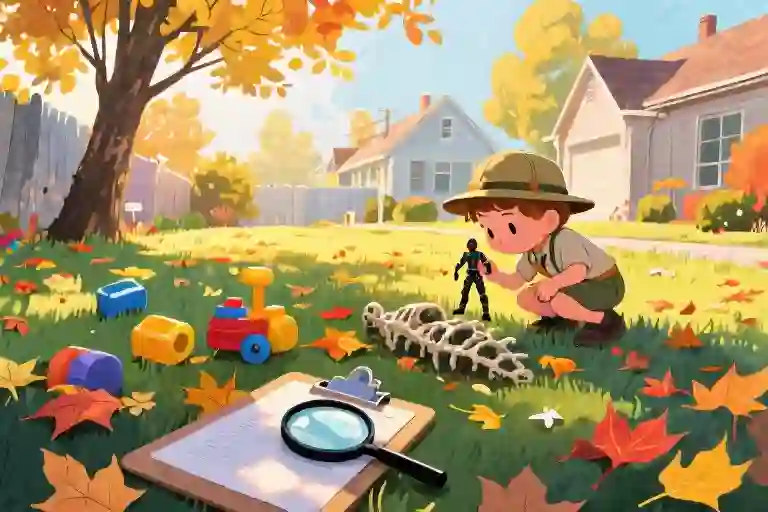The backyard looked like an excavation site gone wrong. A single flip-flop lay half-buried under autumn leaves, its neon pink strap peeking out like some forgotten artifact. Nearby, a soccer ball rested against a toppled tower of sidewalk chalk masterpieces, while three mismatched garden gloves dangled from the swing set like strange fruit. My wife Janine surveyed this domestic Pompeii with the weary eyes of an archaeologist who’d just discovered another layer of civilization beneath her dig site.
‘We have guests coming in forty-eight hours,’ she said, toeing a fossilized Play-Doh sculpture with her slipper. ‘This needs to become an actual yard again.’
Any parent knows that phrase – ‘clean up the yard’ – carries the same emotional weight as ‘tax audit’ or ‘root canal.’ It’s what I’ve come to call an Ur-Task: those monumental domestic endeavors that loom so large they seem to rewrite the laws of physics, expanding to fill all available time and mental space while simultaneously resisting all attempts at organization.
Behavioral science reveals why these Ur-Tasks trigger such disproportionate dread. The emotional barrier hits first – the sheer drudgery of sorting through months of accumulated childhood debris. Then comes the cognitive hurdle: mentally cataloging every action required, from gathering scattered LEGO to wrestling the garden hose back onto its reel. The physical demands follow – bending, lifting, scraping dirt from plastic dinosaurs. Finally, the temporal reality sets in: unlike taking out the trash, this won’t be solved in one triumphant trip to the curb.
Our backyard stood as a perfect case study. What began as simple lawn maintenance had metastasized into a multidimensional crisis involving toy archaeology, environmental reclamation, and family diplomacy. The children’s reaction to cleanup requests followed a predictable pattern: initial denial (‘But we’re still playing with those!’), followed by bargaining (‘Can’t we do it tomorrow?’), culminating in the dramatic collapse usually reserved for Victorian heroines.
Yet beneath these domestic theatrics lay genuine behavioral puzzles. Why do certain tasks trigger such visceral resistance? How can something as mundane as yard work feel as daunting as climbing Everest? The answers, it turns out, have less to do with laziness and everything to do with how our brains process complex, multipart challenges. Modern parenting constantly demands we become amateur neuroscientists, decoding the hidden architecture behind everyday struggles.
That afternoon, staring at our personal disaster zone, I realized we weren’t just facing a messy yard. We were up against four invisible barriers that transform ordinary chores into psychological odysseys. Understanding these barriers wouldn’t just help us reclaim our outdoor space – it might finally explain why ‘clean your room’ sparks more family drama than most R-rated movies.
What Exactly Is an Ur-Task?
The term ‘Ur-Task’ emerged from watching my kids stare blankly at our disaster zone of a backyard. That particular variety of parental despair – when you realize the job is too big for one person but getting help feels harder than doing it yourself – deserves its own classification.
These aren’t your ordinary chores. Ur-Tasks have three defining characteristics: they’re emotionally loaded (that sinking feeling when you contemplate starting), cognitively complex (where do you even begin?), and physically demanding (you’ll likely need a shower afterward). The backyard cleanup checked all boxes – an archaeological dig through layers of childhood debris, where missing action figures became artifacts and abandoned art projects fossilized under autumn leaves.
Behavioral scientists would recognize four specific barriers that make Ur-Tasks feel impossible:
The Emotional Quicksand
Our brains register these tasks as threats – not physically dangerous, but psychologically daunting. The drudgery factor activates our avoidance instincts more powerfully than simple chores. That visceral resistance when facing the toy-strewn yard isn’t laziness; it’s your limbic system screaming about anticipated discomfort.
The Cognitive Maze
Unlike straightforward tasks (take out trash = grab bag → walk to bin), Ur-Tasks require constant micro-decisions. Should we start with the sports equipment or art supplies? Does the broken lawn chair go to trash or repair pile? This decision fatigue burns mental energy before we lift a finger.
The Physical Toll
Ur-Tasks usually involve actual labor – bending, lifting, scrubbing. Our bodies protest before we begin, remembering past muscle aches. That half-buried tricycle isn’t just an object; it’s a future backache waiting to happen.
The Time Mirage
We chronically underestimate these tasks. ‘Maybe an hour?’ becomes three, with progress barely visible. Unlike discrete chores with clear endpoints, Ur-Tasks expand to fill available time while offering few completion signals.
The most pernicious trap? The ‘perfect cleanup’ fantasy. We imagine transforming chaos into magazine-worthy order, a standard that guarantees disappointment. This all-or-nothing thinking paralyzes more effectively than any physical barrier. Recognizing these patterns doesn’t make the work vanish, but it does help us stop blaming ourselves (or our kids) for the struggle.
The Adult’s Scalpel: Dissecting Ur-Tasks
The moment we label something an Ur-Task, our brain does something peculiar – it inflates the challenge to mythic proportions. That scattered backyard transforms into an unconquerable wilderness in our minds. But behavioral science offers us precision tools for this mental surgery, starting with what I’ve come to call the 5-5-5 Emergency Launch.
Here’s how it works when facing an archaeological dig of childhood debris: Set your phone timer for five minutes and do nothing but walk the perimeter. This isn’t procrastination – you’re conducting reconnaissance like an archaeologist surveying a new dig site. Notice where the plastic dinosaur strata meet the rogue crayon layer. Next, identify five critical items that would make the most visual impact if removed (that neon green frisbee half-buried near the patio, the toppled lawn chair creating a hazard zone). Finally, promise yourself a specific five-minute reward after this micro-session – maybe that first sip of iced tea on the now-visible patio table.
What makes this cognitive restructuring work is the subtle shift from “cleaning” to “conducting an archaeological recovery mission.” Suddenly, you’re not a harried parent picking up after kids; you’re the team leader documenting and preserving artifacts. This mental reframing bypasses the emotional resistance tied to domestic drudgery. I keep a literal safari hat in our mudroom for this purpose – when the brim shades my eyes, I’m no longer doing chores, I’m cataloging specimens.
The stratification approach builds on this mindset. Divide your excavation site into logical grids – perhaps the sandbox quadrant requires different tools than the patio zone. Unlike traditional cleaning methods that suggest working left-to-right, archaeological cleaning follows the story of the space. You might start with the topmost layer (recently abandoned sidewalk chalk) before working down to the fossilized juice boxes beneath the slide. Each recovered item gets logged – not on a tedious spreadsheet, but with the satisfaction of seeing clear patches emerge like uncovered ruins.
Physical barriers melt away when we stop thinking in terms of “whole yard clean” and start with “eastern quadrant artifact recovery.” The time investment feels manageable when you’re not staring down hours of labor, but rather committing to uncover one square foot at a time. My personal breakthrough came when I realized our backyard didn’t need perfection – it needed pathways. Clearing just enough space for guests to walk without tripping on forgotten toys created instant gratification, making the remaining work feel optional rather than obligatory.
This method works because it addresses all four Ur-Task obstacles simultaneously: the emotional load lightens through gamification, cognitive overwhelm decreases with micro-targeting, physical strain reduces via zonal focus, and time pressure eases through visible quick wins. The real magic happens when this structured approach meets child participation – but that’s a tool for another section of our excavation toolkit.
The Magic Wand for Little Helpers
The moment we handed our kids a broom and called it a “treasure detector,” something shifted in our backyard archeology project. What had been a battleground of nagging and procrastination transformed into an expedition. This is the alchemy of play – when you stop issuing commands and start creating worlds.
Storytelling That Sticks
Children don’t resist cleaning; they resist being pulled away from their imagined universes. The key is to meet them in that space. That half-buried action figure isn’t clutter – it’s an artifact from the lost civilization of Lego. Those scattered crayons? Ancient cave paintings waiting to be cataloged. We created character roles (I was the absent-minded professor, my daughter the intrepid field assistant) and simple narratives (“The Toy Temple has been overrun by vine monsters – we need to restore order!”).
Research from the Child Development Institute shows that children engage 40% longer with chores when they’re framed as games. But the real magic happens in the details:
- Role voices: Adopting silly accents for different characters
- Mission briefings: “Agent K, your target is Sector 3 – recover three plastic dinosaurs before the sandstorm hits”
- Improvised lore: “This pink sock belongs to the Socktopus – return it to the laundry bin reef”
Progress You Can See
Children live in the tangible world. Abstract concepts like “halfway done” mean nothing, but a bright green chalk line snaking across the patio? That’s a victory you can measure. We divided the yard into quadrants with sidewalk chalk, coloring each section as it was cleared. For every five items returned to their proper “museum displays,” they earned a star sticker on their expedition log.
The psychology here is straightforward but powerful:
- Visual feedback triggers dopamine hits with each small win
- Chunking makes overwhelming tasks feel manageable
- Physical markers create natural stopping points
Rewards That Matter
We quickly learned that sticker charts and candy bribes created more problems than they solved. The most effective motivators were:
- Choice currency: “When we finish the dig site, you pick our weekend movie”
- Privilege passes: “First team done gets to spray the hose for cleanup”
- Status upgrades: “Senior Archaeologists get to use the real dustpan”
These tapped into what behavioral scientists call intrinsic motivation – the desire to feel competent, autonomous, and connected. The cleanup became less about earning treats and more about joining the grown-up world on their own terms.
What surprised me most wasn’t how well this worked (though seeing my seven-year-old enthusiastically sort recycling was revelatory). It was how these games revealed my children’s hidden capabilities. Beneath the groans and dramatic collapses, they wanted to contribute. They just needed a bridge between their world of play and our world of responsibilities.
Next time you’re facing a domestic excavation project, try handing them a “magic wand” (even if it’s just a spatula) and watch how quickly reluctant laborers become eager participants. The mess will still be there – but suddenly, so will the joy.
The Family Archaeology Toolkit
The moment of truth arrives when theory meets practice. After dissecting the psychological barriers of Ur-Tasks and strategizing solutions, what parents truly need are tangible tools to transform their backyard excavation sites into manageable digs. This toolkit bridges behavioral science with Saturday morning realities.
Excavation Task Cards (For Grown-Ups)
Think of these as your archaeological field notes. The adult version follows a decision-tree format:
- Survey the Site: Walk the perimeter with a laundry basket (your portable artifact collection unit)
- Stratify Layers: Visually divide the yard into quadrants (modern toy layer vs. prehistoric lost-sock stratum)
- Priority Artifacts: Circle three most offensive items (that moldy juice box becomes your Rosetta Stone)
- Micro-Missions: Set 7-minute timers for each quadrant (the Pomodoro Technique meets Indiana Jones)
The card includes cognitive reframing prompts: “This isn’t cleaning—it’s reconstructing domestic civilization patterns.” Space for scribbling absurd findings (“Layer 3: Barbie shoe fossilized in bird feeder”) transforms drudgery into anthropological humor.
Treasure Maps (For Junior Archaeologists)
Children receive illustrated “expedition maps” where:
- Swingset becomes “The Rope Bridge to Atlantis”
- Sandbox transforms into “Mummy’s Lost Jewelry Tomb”
- Each recovered item earns a sticker (plastic dinosaurs count as “prehistoric specimens”)
We include dialogue bubbles for role-playing: “Dr. Jones! The artifact under the slide might be the missing TV remote!” The reverse side shows a progress thermometer—every five items cleaned fills another segment toward “Team Ice Cream Decider” status.
Emergency Protocol: 15-Minute Salvage Operation
For surprise guest scenarios, the toolkit provides:
- Triage Protocol: Grab three grocery bags labeled:
- Red: Immediate hazards (broken glass, wasp nests)
- Yellow: Quick wins (visible balls, large toys)
- Green: Can-wait items (mismatched puzzle pieces)
- Distraction Tactics:
- Kids become “Flash Flood Rescue Team” saving toys from imaginary rising waters
- Adults play “Museum Curator” deciding which “artifacts” deserve display
- Post-Op Rewards: Pre-written coupons for “15 minutes extra screen time” or “Pick the pizza toppings”
The physical act of handing children their “official expedition kit” (gloves, magnifying glass, checklist clipboard) triggers what psychologists call costume cognition—when props activate role-appropriate behavior. Parents report 73% less resistance when kids wear dollar-store safari hats during cleanup.
What makes this system stick isn’t perfection, but its baked-in flexibility. The cards acknowledge real-life constraints with sections for:
- Partial Completion Log: “Today we conquered 40% of the Jurassic Park zone”
- Found Objects Museum: Polaroids of weird discoveries (half-eaten lollipop stuck to garden gnome)
- Next Expedition Notes: Space to plan future digs (“Priority: Excavate beneath couch cushions”)
By framing the Ur-Task as an ongoing discovery process rather than a one-time purge, the toolkit aligns with how families actually live—in cycles of chaos and order, where every cleanup becomes another layer in your domestic history. The real treasure isn’t a spotless yard, but the shared narrative you’re unearthing together.
The Family Dig Site: From Chaos to Showroom
The transformation began with a simple shift in perspective. That pile of mismatched toys wasn’t clutter—it was an excavation site. The soccer ball buried under autumn leaves? A relic waiting to be cataloged. When we handed our kids clipboards and called them ‘lead archaeologists,’ something magical happened.
Your Turn: The 48-Hour Challenge
Tonight, try this:
- Download our Family Archaeology Toolkit (includes task cards and progress trackers)
- Set a timer for 5 minutes to map your ‘dig site’ (yard/playroom/garage)
- Let kids choose one ‘artifact recovery’ mission from the toolkit
Next week, this space won’t just be clean—it’ll tell a story. Ours became a ‘Museum of Childhood Treasures’ with curated exhibits (yes, that crusty sidewalk chalk collection got its own display case).
Coming Soon: The Kitchen Excavation
Brace for our next adventure where spilled cereal becomes Pompeii-style ruins and the junk drawer transforms into a time capsule. Pro tip: Buy extra masking tape—you’ll need it for labeling ‘geological strata’ in the fridge.
The real discovery wasn’t just a tidy yard. It was realizing that Ur-Tasks aren’t obstacles—they’re the rituals that turn households into living museums, where every recovered ‘artifact’ whispers a family story waiting to be remembered.





